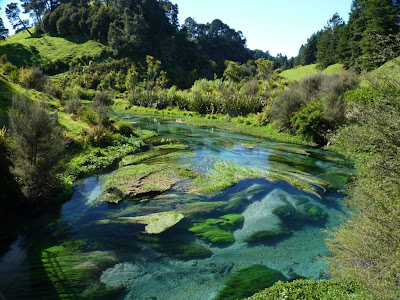So it is time to bring this blog back to life. A full cycle of equinox events have passed since the last post, but our panniers have once again been packed and the bikes boxed. This is the year we have opted for skipping a Sierra winter for travel in New Zealand.
The journey began on October 16 from San Francisco. My Wonderful Sister and Equally Great Brother-in-Law once again allowed us to park our car in their garage for the duration of our five-month trip, and delivered us and our boxes to the airport. Rolling our cargo into check-in, the clerk said the flight was overbooked, and if we might consider volunteering to take the same flight the next day. They would put us up in a hotel, and give us $800 (each!!). John hesitated, and looked at me. He must have seen the dollar signs come up in my eyes when I blinked. So we said, sure, why not?
 |
| John and bikes in the Air New Zealand queue. |
We were told to go through security and wait at the Evergreen Lounge for Air New Zealand travelers. We would be on standby, and if they needed us to take the flight the next day, they would find us there. So for the next three hours we rubbed elbows with the Executive Class passengers, sat in cushy leather chairs, drank Heineken beer, munched on curry chicken, surfed the Internet, and made plans for what we would do with a free day in San Francisco. We were almost convinced we would be bumped, and heck, if we got bumped on the way home, too, we would make money on this trip!
So we waited. People started to leave when first boarding was called. Pretty soon we were the last ones in the Lounge. And finally the receptionist said we better get going...they did not need us for standby after all. Flip-flop, back to Plan A.
There is not much to say about a 13 hour plane ride, other than sleep is rough and you feel like a pretzel when you finally get off. But I watched three movies on my own personal screen, which is a big fix for this popular culture-deprived soul.
It was just past 6:30 am upon arrival in Auckland, and the airport was just waking up. John found the designated Bike Assembly Area, complete with a rack, where he spent a couple of hours putting the our pieces back together. Conveniently located next to the smoking area and the McDonalds exhaust vent. Rain showers came and went outside, but the statue of
Jean Batten seemed to indicate when it was time to go.
 |
| New Zealand's way of saying "Welcome Cyclists". |
 |
| A rainbow signals clearing skies. |
We cycled across town to a campground located almost in city center. And the next day we took care of business – buying camping fuel, finding an ATM for cash, and getting a
Telecom T-Stick for Internet access. It took almost three hours to get the stick working on our
Ubuntu-powered netbook, but after a bit of hacking we were successful. After a big lunch at the Asian Food Mall, we pedaled around the bay for some nice views of expensive houses perched on cliffs and the city in the distance.
 |
| The skyline of Auckland's city center -- the Sky Tower is the most prominent feature and the tallest structure in the southern Hemisphere. |
The New Zealand journey has begun, and this blog is once again alive!






























